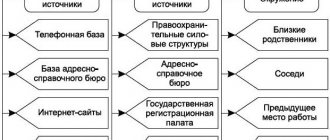Thanks to an aggressive advertising campaign that comes from “every iron,” residents of our vast Motherland who use the Internet or social networks are confident that bankruptcy is a legal way to “zero out” debts. And then - live happily ever after. Probably, those who have not encountered this procedure “live” think that our legislators have lost their minds if they created such a scheme for scoundrels. However, you don’t need to believe everything that is written on the World Wide Web.
Yes, being declared insolvent allows you to ease the debt burden for law-abiding citizens. But, as judicial practice shows, this is one of the last opportunities for creditors to get “their” money back. (Bins of cement and forest walks in the fresh air do not count). So, even if your debtor is cunning, and he decided to hide from creditors, bailiffs and even investigators, it will be more difficult for him to escape from bankruptcy. You can bankrupt a person even when he is physically absent.
For this purpose, the current legislation provides for bankruptcy of an absent debtor. What it is? Let us explain what the procedure consists of:
- The concept and features of bankruptcy of an absent person;
- Signs of an absent debtor in bankruptcy;
- Financing of simplified bankruptcy;
- Features of the consideration of the case;
- Step-by-step instructions for bankruptcy of an absent debtor;
- The meaning of simplified production.
Concept and features of bankruptcy of an absent person
So, what kind of procedure is this and why is it needed? It's very simple: imagine that your debtor (a person or director of a legal entity) went on the run shortly before bankruptcy began. It is possible that he managed to get rid of property (personal or company) in advance. So what should creditors do in such a situation? "To understand and to forgive?". But “No!”, the bankruptcy law tells us briefly and clearly.
For such cases, an accelerated procedure is provided in the absence of a debtor. What is it? The court will not “pull the cat for details” and apply the following procedures: supervision, financial recovery, but will immediately declare the debtor bankrupt and open bankruptcy proceedings (for legal entities). Or the court will introduce the sale of property - for individuals. The main feature of this type of procedure is the absent debtor, and the amount of the debt does not matter. Although, it’s probably stupid to initiate it for the sake of a debt of 10,000 rubles.
However, the debtor may “get lost” after the launch of bankruptcy and the introduction of one of the procedures, say, debt restructuring. Then the temporary or financial manager submits a corresponding application to the court to switch to a simplified procedure.
Bankruptcy of an absent debtor - how is this possible?
According to Federal Law No. 127-FZ “On Insolvency (Bankruptcy)”, in the event of bankruptcy of an absent person, including in the event of his death, a simplified procedure is applied. That is, in other words, the absent debtor in a bankruptcy case is not an obstacle to its consideration. The burden of proving the impossibility of establishing the location of a citizen or head of an organization falls on the applicant.
Absent debtor in bankruptcy case
Based on Ch. II clause 1 art. 227 of Law No. 127-FZ, an individual or head of an organization whose location is unknown and cannot be identified is recognized as absent. In order for the court to recognize the debtor as absent, 4 conditions must be met:
- any activity aimed at generating income or profit was discontinued more than 12 months ago;
- all types of financial transactions on the accounts have not been carried out for more than a year;
- long-term absence from the place of official registration (for organizations - legal and actual addresses, for citizens - place of registration);
- impossibility of establishing the location of the defaulter.
The court approves the bankruptcy of legal entities due to their absence if:
- the location of the director or founders is unknown, there is no one at the addresses indicated in the registration documents;
- the company's current accounts are empty and there has been no movement on them over the past 12 months;
- the location of assets and fixed assets cannot be determined.
If bankruptcy proceedings are initiated against an individual due to his absence and evasion of debt obligations, the creditor needs to obtain a court ruling that the debtor is indeed absent.
This procedure is regulated by Art. 42 of the Civil Code of the Russian Federation and prescribes:
- the creditor must file a claim with the court at the place of registration (last place of residence) of the debtor;
- the essence of the statement of claim is to recognize the citizen as dead or missing;
- Having considered all the materials presented, the court will make a decision and issue an order to consider the debtor absent or for years.
Having received a court order confirming the assignment of missing person status to the debtor, the creditor can initiate bankruptcy proceedings. At one of the plenums, the Supreme Court of the Russian Federation ruled that the creditor does not have to obtain a court ruling declaring a citizen absent. But in a bankruptcy case, the lender must prove that the debtor does not live at the place of registration and the search did not produce results.
In practice, it is quite difficult to provide significant evidence confirming the disappearance of the debtor. Therefore, if the amount of debt is large, it is better for lenders to act within the framework of the Civil Code of the Russian Federation.
Signs of an absent debtor in bankruptcy
The signs will vary depending on the person - physical or legal.
So, for a legal entity, not only the flight of the director is a mandatory condition, because the owners of the company can change directors at any time. But also the actual cessation of the company's activities. So, if an organization has not provided tax reporting and has not carried out transactions on bank accounts within 12 months, it may be excluded from the state register.
For individual entrepreneurs, this period is 15 months, and now the Federal Tax Service is actively excluding from the register of individual entrepreneurs “sleeping” entrepreneurs who have not submitted reports since the beginning of the coronavirus pandemic in April 2020.
Information about the upcoming exclusion of an LLC is posted in the Unified State Register of Legal Entities, an extract from which can be ordered on the Federal Tax Service website in the “Transparent Business” section.
For an individual, confirmation can be a court decision to recognize a person as missing, or to put him on the wanted list (federal or even international). Or a death certificate and opening a case on inheritance procedure with a notary - if the person has died.
Legal position of the Supreme Court of the Russian Federation on an absent debtor
The Supreme Court of the Russian Federation has formulated a legal position on the issue of bankruptcy of an absent debtor.
The case was referred to the Supreme Court of the Russian Federation after the courts of three instances, having established that the general director of the debtor had received correspondence at his registration address, refused to declare the debtor bankrupt under the simplified procedure for an absent debtor.
Having considered the case, the Supreme Court of the Russian Federation formulated a legal position, according to which, the absence of signs of an absent debtor in a company should entail either consideration of the case in accordance with the general procedure of the Bankruptcy Law, or termination of the proceedings, and not a refusal to declare the debtor bankrupt.
The reasons for this legal position are as follows:
In accordance with paragraph 1 of Article 227 of the Bankruptcy Law, an application for declaring an absent debtor bankrupt may be filed by a bankruptcy creditor, an authorized body, regardless of the amount of accounts payable in cases where a citizen - debtor or the head of the debtor - a legal entity that has actually ceased its activities, is absent or It is not possible to establish their location.
The provisions provided for in paragraph 2 of Chapter XI of the Bankruptcy Law also apply if the property of the debtor - a legal entity obviously does not allow covering legal costs in connection with the bankruptcy case or if during the last twelve months before the date of filing the application for declaring the debtor bankrupt transactions were carried out on the debtor's bank accounts, as well as in the presence of other signs indicating the absence of entrepreneurial or other activities of the debtor (Article 230 of the Law).
During the consideration of the case, the court of first instance established the fact of receipt of postal notifications at the place of residence of the general director of the debtor, which excluded the application of the provisions of Article 227 of the Bankruptcy Law, but did not prevent the verification of the presence (absence) of the company of signs of an absent debtor, provided for in Article 230 of this Law, referred to by the authorized body.
To apply Article 230 of the Bankruptcy Law, one of the grounds given therein is sufficient:
— absence of the debtor’s property or funds necessary to introduce bankruptcy;
— absence of transactions on the debtor’s bank accounts during the last twelve months;
- the presence of other signs indicating the absence of entrepreneurial or other activities of the debtor.
In support of the arguments, the authorized body provided evidence of the absence of the debtor at the registration address and conducting transactions on the current account; interim tax reporting for 2021 with zero values; information from relevant authorities regarding movable and immovable property; terminated enforcement proceedings on the grounds of paragraph 3 of part 1 of Article 46 of the Federal Law of October 2, 2007 No. 229-FZ “On Enforcement Proceedings” (it is impossible to establish the location of the debtor, his property or to obtain information about the availability of funds belonging to him and other valuables located in the accounts , in deposits or in storage in banks or other credit institutions).
At the same time, verification of the arguments of the authorized body and the legal assessment of the evidence presented by it is essential for the possibility of introducing a simplified procedure for an absent debtor on the basis of Article 230 of the Bankruptcy Law, given that the debtor did not comply with the ruling of the court of first instance dated December 6, 2019 to provide evidence, not appeared at court hearings at any of the instances.
There are no objections from the debtor that refute the arguments of the authorized body in the case materials.
The panel of judges considers it necessary to note that, in accordance with Article 55 of the Bankruptcy Law, the decision of the arbitration court to refuse to declare the debtor bankrupt is made in the absence of signs of bankruptcy provided for in Article 3 of the said Law, as well as in other cases provided for by the Bankruptcy Law.
By virtue of paragraph 2 of Article 3 of the Bankruptcy Law, a legal entity is considered unable to satisfy the claims of creditors for monetary obligations, for the payment of severance pay and (or) for wages of persons working or who worked under an employment contract, and (or) to fulfill the obligation to make mandatory payments , if the corresponding obligations and (or) obligations are not fulfilled by him within three months from the date on which they should have been fulfilled.
In the bankruptcy application, the authorized body referred to the company's debt on obligatory payments in the amount of 320,669.62 rubles, which arose earlier than three months before filing this application with the arbitration court.
The conditions allowing to conclude that the debtor does not have signs of bankruptcy, provided for in Article 3 of the Bankruptcy Law, were not established by the court of first instance; other grounds provided for by the Bankruptcy Law for making a decision to refuse to declare the debtor bankrupt were not identified.
In this regard, the court’s conclusions about the existence of grounds for a decision to refuse to declare the debtor bankrupt should be considered premature, based on the incorrect application of the provisions of the Bankruptcy Law.
If, when considering the issue of declaring a debtor bankrupt under a simplified procedure, the court comes to the conclusion that there are no signs of an absent debtor, then the applicant should be asked about the possibility of continuing the consideration of the case in the general manner (introducing a monitoring procedure, the possibility of imposing costs on the applicant in the case, etc.). d.). If the applicant refuses to apply another procedure, the proceedings are subject to termination.
Step-by-step instructions for bankruptcy of an absent debtor
Here is a small action plan for how to “stir up” such a procedure:
- First, you need to lend someone an indecently large amount of money in order to create a debt to you. Alternatively, you can accumulate alimony debt.
- After your “offender” has ignored all the deadlines for the return of funds, you go to a court of general jurisdiction at the location of the defendant and collect (if you can prove) the debt from him. If the decision of the first instance does not suit you, you can challenge it on appeal.
- You receive a writ of execution and send it to the FSSP of Russia. If the bailiff cannot find the debtor or his property, then after a while you will receive back a writ of execution with the wording: “it is impossible to establish the location of the debtor, etc. and so on.".
- You apply to the arbitration court with a statement of insolvency of the absent debtor. The jurisdiction of this process is also determined by the last known place of residence. The application must be accompanied by evidence confirming the absence of the debtor or the impossibility of establishing his location. Unfortunately, the courts will not take your word for it.
- You watch with bated breath the work of the financial manager to find and return the property of a legal or individual person to the bankruptcy estate for the distribution of its debts.
You can find out whether the process of declaring him insolvent has been launched in relation to a person, individual entrepreneur or legal entity, on the website of the arbitration courts “My Arbitr”.
Who can file a bankruptcy petition for an absentee defaulter?
The procedure can be initiated by any of the creditors, a representative of the tax authority, or bailiffs (if the obligations under the writs of execution are not fulfilled and the debtor is hiding). In this case, the amount of debt does not matter. The plaintiff must prove the absence of a legal or natural person and pay all costs associated with the procedure, including remuneration to the insolvency administrator.
The debtor himself has the right to initiate bankruptcy under a simplified procedure; to do this, the following conditions must be met:
- economic activity is not actually carried out for a long time;
- there has been no movement on current accounts for more than 12 months, mandatory contributions have not been paid (to the tax office, the Pension Fund);
- the cost of bankruptcy proceedings exceeds the book value of assets.
If during the reorganization the financial manager discovers that the director or founder of the legal entity is absent for a long time, then he is obliged to file a bankruptcy petition for the absent debtor. The court will appoint a simplified procedure and the manager will proceed to the stage of bankruptcy proceedings.
Probable mistakes of the lender and dangerous consequences
If the debtor is already in bankruptcy proceedings, the actions of the creditor should be weighed as much as possible. Unprofessional “entry” into bankruptcy, the position of an outside observer during the procedure is fraught with dangerous consequences.
So, what mistakes can a creditor make in a situation where bankruptcy proceedings have already been initiated by the debtor or his friendly creditors?
Missing the 30-day deadline for submitting an application for inclusion in the register of creditors
Missing the legally established thirty-day period for filing an application for inclusion in the register of creditors actually leaves the creditor “out of the register.” The period is calculated from the moment the debtor publishes information about the beginning of bankruptcy. Despite the fact that claims can be made after this period, the chances of receiving the funds due from the debtor tend to zero.
As practice shows, there is simply no money left for “registered” creditors.
In addition, “latecomers” are deprived of the opportunity to participate in the first meeting of creditors, at which strategically important decisions are made. They are limited in their rights: in fact, they do not have the opportunity to influence the decisions of the general meeting of creditors, express disagreement regarding the inclusion of claims of other creditors in the register, and, in general, productively control the progress of the procedure and resist the “withdrawal” of assets in favor of affiliates.
It is extremely dangerous for a secured creditor to miss the deadline for submitting an application for inclusion in the register. He may lose the priority right to receive money from the sale of the collateral property.
Passive position of the creditor. Lack of control over the actions of the arbitration manager
The passive position of the creditor, inaction in relation to gross violations of the bankruptcy law and inattention to small details - the quasi-legal techniques of the arbitration manager - inevitably lead to the impossibility of the creditor receiving the money due.
An arbitration manager acting on the debtor’s side may not fulfill his direct duties and unreasonably extend the bankruptcy procedure.
And the main thing is not to conduct, or to conduct only “for appearance’s sake,” the collection of the bankruptcy estate: do not take the initiative to challenge suspicious transactions, do not take measures to collect receivables, do not hold the managers and owners of the debtor company to personal property (subsidiary) liability.
The lack of necessary control over the condition of the pledged property and other assets leads to the sale of objects from the bankruptcy estate at the price of “scrap metal”. As a result, there are no funds left for creditors.
Uncontrolled auctions, as well as uncontrolled preparation for them, are a fertile field for abuse on the part of the debtor and the bankruptcy trustee. In particular, an unscrupulous arbitrator can in every possible way prevent the participation of a wide range of buyers in the auction, “draining” assets to interested parties at a reduced price. This also leads to a reduction in the amount intended for settlements with creditors.
“Random” errors in the order of distribution of money between creditors cannot be ruled out.
Who is an absentee defaulter?
Citizens who have previously regularly repaid their loans may not be able to cope with the psychological stress and begin to hide when faced with financial difficulties. An absent defaulter is also considered to be the head of a legal entity or an individual who hides his location in the event of potential bankruptcy.
Free consultation
In cases where all measures to establish the location of the defaulter have not led to a positive result, the creditor or judicial authority has the right to initiate bankruptcy proceedings for the absent debtor.
Procedure algorithm
As part of the simplified form of the process of declaring a defaulter bankrupt, the procedure performed in relation to the absent debtor is as follows:
- Filing an application to the Arbitration Court.
- Consideration by the court of the evidence provided, making a decision that satisfies the applicant’s requirements.
- Appointment of a bankruptcy trustee.
- Informing creditors according to the compiled list.
- Formation of creditors' claims.
- Search for property and the borrower himself.
- Selling the found property and dividing the proceeds among all creditors.
When can a subject be declared absent?
The process of assigning bankrupt status to a business entity is applicable to both legal entities and individuals. The vast majority of bankruptcy cases under the simplified scheme are initiated against shell companies that were created to conclude a couple of transactions and then were abandoned. But there are also situations when the case is also in relation to apparently prosperous and stable enterprises, the owners of which turned out to be unable to pay their obligations and chose to disappear.
To determine the signs of bankruptcy of a debtor, certain factors are taken into account.
- Complete non-payment of tax and loan payments during the year.
- Complete silence on all subject's bank accounts.
- No reporting for 12 months.
- Absolute calm in any type of activity.
- The value of the property of the missing person cannot cover the costs associated with the insolvency claim.
- The impossibility of determining the actual place of residence of an individual (in accordance with registration) and the manager, if we are talking about the liquidation of a legal entity.
The judge will consider the fact of the defendant’s disappearance as a sign of the debtor’s bankruptcy only if attempts to find and establish contact with the disappeared person find documentary evidence.
If all the signs of an absent debtor in bankruptcy are present, this is considered sufficient grounds for filing an application with the arbitration court.
How does simplified bankruptcy of a legal entity proceed?
Let's consider how simplified bankruptcy proceeds in relation to a liquidated organization and an absent debtor.
Simplified procedure for bankruptcy of a liquidated debtor
The decision to liquidate the company is made by the founders.
After the appointment of a liquidator, the bankruptcy of the liquidated debtor proceeds according to the following scheme:
- An application to begin the liquidation process is sent to the tax authority. Based on the information received, a record of the beginning of the procedure is made in the Unified State Register of Legal Entities. The functions of managing the company are transferred to the liquidator.
- If there is a debt to creditors that is not covered by the company’s property, the liquidator publishes a message on the simplified bankruptcy procedure on the EFRSB portal.
- A notice of the commencement of the liquidation and bankruptcy procedure is sent to creditors, the authorized body and extra-budgetary funds.
- The liquidator makes inquiries to Rosreestr, the Federal Tax Service, Rospatent, and other departments about the availability of property registered with the debtor. A reconciliation of taxes and fees is carried out. An interim balance sheet is sent to the Federal Tax Service, containing information about the existence of a debt to creditors in excess of 300,000 rubles.
- An application for bankruptcy of the company is filed with the arbitration court. The court sets a date and time for trial to consider the application. At the first meeting, a decision is made to declare the debtor bankrupt, open bankruptcy proceedings and appoint a bankruptcy trustee.
- Within a month after the opening of bankruptcy proceedings, creditors make claims against the debtor. The bankruptcy trustee creates a register of creditors' claims.
- During bankruptcy proceedings, an inventory of property is carried out, receivables are collected, debts to creditors are repaid, and the debtor's accounts are closed.
- After all settlements are closed, the final liquidation balance sheet is formed. The court issues a ruling to terminate the bankruptcy case. Based on a judicial act, the liquidated company is excluded from the Unified State Register of Legal Entities.
From the moment of complete liquidation, the company's debt is considered repaid. Creditors lose the right to collect it.
Example from judicial practice 1. The liquidator of an LLC “applied to the court with an application to declare the company insolvent and to open bankruptcy proceedings against it according to the simplified procedure applied to the debtor being liquidated. The requirement is justified by the fact that the general meeting of founders made a decision to liquidate the company, which was recorded in the Unified State Register of Legal Entities. The debtor compiled an interim liquidation balance sheet, from which it follows that the company has current assets in the amount of 5,960,755 rubles. There are no accounts receivable. There is no other property sufficient to pay off debts to creditors. The company's debt to creditors amounts to RUB 13,162,325.59. The court decided to declare the LLC bankrupt and open bankruptcy proceedings against the liquidated debtor (Resolution of the Arbitration Court of the Volga-Vyatka District dated February 24, 2015 in case No. A38-806/2014).





